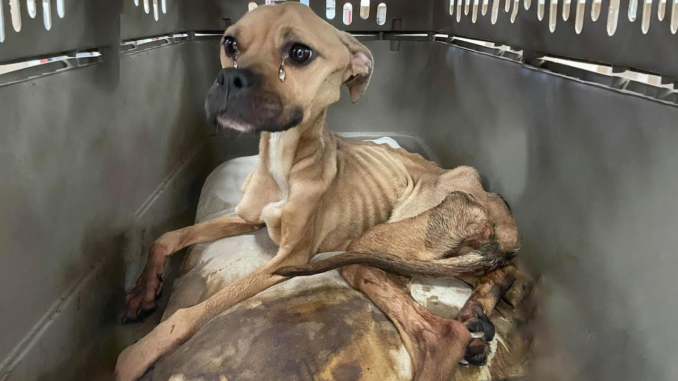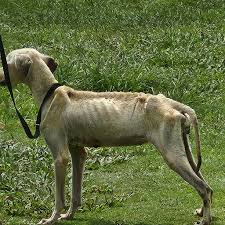
The world is full of heartwarming tales of animals being rescued from abuse, but there are also stories that highlight the cruelty and neglect that far too many pets face. One such story is that of a dog who was left to suffer for months without food, reduced to nothing but skin and bones, unable to stand or move. Her story is a stark reminder of the realities of animal abuse and the urgent need for better protection and care for these innocent creatures. In this article, we’ll explore what led to this heartbreaking situation, how she managed to survive, and the importance of rescue efforts in saving animals from neglect.
The Dark Side of Neglect: A Dog Left Without Food
Neglect is a form of abuse that often goes unnoticed, especially when animals are left alone in quiet, hidden spaces. It can take many forms, from lack of food and water to emotional abandonment. For this particular dog, her life was marked by extreme neglect. Left without food for an extended period, she began to wither away. Her body became a shell of its former self, nothing more than skin and bones. This kind of neglect is not just a failure to provide for an animal’s basic needs—it’s a clear indication of cruelty and a disregard for the well-being of a living creature.
The Consequences of Starvation: A Body Slowly Wasting Away
When a dog goes without food for an extended period, their body starts to break down in severe ways. Starvation leads to muscle wasting, a decline in organ function, and an overall collapse of the dog’s health. In severe cases like this one, the dog’s body becomes emaciated—ribs and spine visible under thin, sagging skin. Her muscles were so weak from lack of nutrition that she couldn’t even stand. The process of starvation is slow, agonizing, and can lead to death if left unaddressed.
But this dog didn’t die. She hung on, her body fighting the inevitable. How did she manage to survive? What kept her going through those dark, hungry months?
The Power of Survival: What Keeps an Animal Alive During Extreme Neglect?
When animals are subjected to extreme neglect, their instinct to survive can sometimes outweigh the odds. Despite being reduced to skin and bones, this dog managed to hold on. It’s likely that her will to live kept her going, even when everything seemed hopeless. Like many animals in survival situations, she may have relied on every ounce of energy in her body to find water or shelter, even if she couldn’t stand up.
The resilience of animals in such dire conditions is remarkable. Their instincts often drive them to search for food or shelter, even when their physical state seems beyond repair. This survival instinct is part of the reason why some abused animals manage to survive the unthinkable.
How Rescue Efforts Save Neglected Animals: The Hope for a Better Life
Thankfully, rescue organizations and compassionate individuals step in to help animals in desperate need. When this dog was finally discovered, she was barely alive—her body frail and weak, but her spirit still intact. Rescue efforts are critical in cases like this one, where animals are left to suffer without any hope of survival. Veterinarians and animal rescue workers provide the care and rehabilitation that these animals need to regain their health.
In this dog’s case, the road to recovery was long. She needed a specialized diet, medical treatment, and consistent care. It’s not just about feeding a malnourished dog—it’s about slowly rebuilding her strength, offering her comfort, and helping her rediscover what it means to be loved.

Rehabilitation and Recovery: Restoring a Starving Dog’s Health
The rehabilitation of a dog who has been starved or neglected takes time and patience. For this dog, it wasn’t just about feeding her immediately—it was about providing small, nourishing meals and allowing her body to adjust. Rapid feeding can cause a condition known as refeeding syndrome, where the body’s organs can be overwhelmed by sudden nutrient intake. Instead, a slow and steady approach was required to help her regain her strength without putting her health at further risk.
Veterinarians monitored her closely, ensuring that she had the proper care and medical attention needed to recover. Slowly but surely, her body began to respond to the treatment. She regained a little strength, and as her muscles rebuilt, she was able to take small steps. Each tiny improvement was a victory—a sign that hope was not lost.
The Emotional Toll of Neglect: How Animals Suffer Mentally
While physical recovery is essential, emotional healing is just as crucial for animals who have been neglected. A dog who has suffered from starvation and neglect often carries emotional scars. The trauma of abandonment can cause anxiety, fear, and distrust. It’s not uncommon for neglected dogs to become fearful of people or other animals, having learned to associate humans with pain and suffering.
For this dog, the process of emotional healing would take time. She would need patience, kindness, and a safe environment where she could trust again. In many cases, neglected animals need gentle reassurance and a quiet place to heal emotionally as well as physically.
Adoption and a New Beginning: Finding a Forever Home
Once this dog’s health began to improve, the next step was finding her a forever home. Adoption is often the best way for rescued animals to fully recover. A loving family can provide the care, attention, and stability that a neglected animal desperately needs. In this case, after months of recovery and emotional healing, the dog found a new family who would cherish her for the rest of her life.
Adopting a dog who has been through neglect is not just about providing a roof over their head—it’s about giving them the love and care they need to heal. It’s about restoring their trust in humans and helping them rediscover the joy of living.
The Importance of Reporting Animal Abuse and Neglect
One of the most critical aspects of preventing cases like this is raising awareness about animal abuse and neglect. If you suspect that an animal is being mistreated or neglected, it’s vital to report it to local authorities or animal rescue organizations. By speaking up, you can help save lives and prevent further suffering. Animal abuse is often hidden, but with the right knowledge and resources, it can be stopped.
Animals rely on us to advocate for their well-being. By reporting neglect, we can ensure that animals like this dog are given a second chance at life, free from pain and suffering.
The Role of Animal Shelters and Rescues in Preventing Neglect
Animal shelters and rescue organizations play a crucial role in addressing the issue of neglect. They provide a safe haven for animals who have been abandoned, abused, or left without food. These organizations often operate on tight budgets and rely on the support of volunteers and donations to continue their work. The efforts of these shelters are essential in not only rescuing animals but also educating the public about responsible pet ownership and the consequences of neglect.
Why We Must All Take Responsibility for Animal Welfare
Ultimately, the responsibility for preventing animal neglect falls on all of us. Whether we are pet owners, animal advocates, or simply compassionate individuals, we all play a role in ensuring the safety and well-being of animals. It starts with education, awareness, and taking action when we witness signs of abuse or neglect. By fostering a culture of kindness and respect for animals, we can help prevent cases like this one from happening in the future.
Conclusion: A Reminder of the Power of Compassion
The story of a dog who was neglected to the point of becoming skin and bones is a painful reminder of the importance of compassion. It’s a testament to the resilience of animals and the power of rescue efforts in giving them a second chance at life. However, it also highlights the need for greater awareness and action to prevent neglect and abuse. Each animal deserves to be treated with kindness and care. If we all work together, we can help ensure that no animal is left to suffer in silence.
FAQs
- What are the signs of neglect in dogs? Signs of neglect in dogs include emaciation, lethargy, untreated medical conditions, and poor living conditions. Dogs may also show signs of fear, anxiety, or aggression due to trauma.
- How can I help a neglected dog recover? Neglected dogs need medical care, proper nutrition, and emotional support. Patience is key, as their physical and emotional healing may take time.
- What should I do if I witness animal abuse or neglect? If you suspect animal abuse or neglect, contact your local animal control agency or animal rescue organization immediately. Reporting is vital to stopping the abuse.
- Can neglected dogs still be adopted? Yes, many neglected dogs go on to live happy, healthy lives in loving homes after receiving proper care and rehabilitation.
-
How can I support animal rescue efforts? You can support animal rescues by volunteering, donating, or spreading awareness about the importance of responsible pet ownership and animal welfare.
